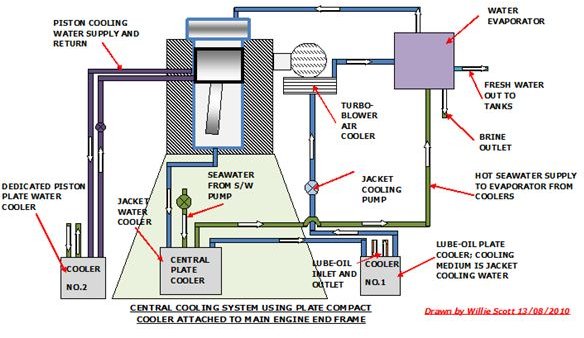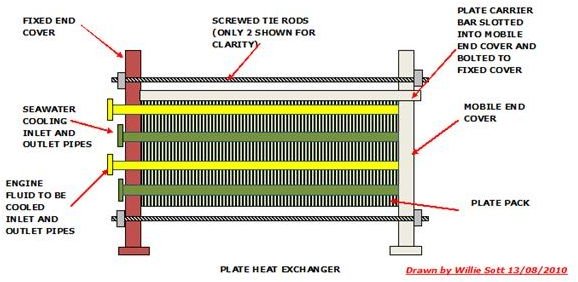New Marine Heater Exchangers - Flat Plate Coolers for Ships Engine Rooms
Introduction to Plate Heat Exchangers.
When I served my time as a marine fitter in Harland and Wolff Belfast in the sixties, I spent a few months in their heat exchanger construction and testing department. In those days and afterwards when I went to sea as a Ships Engineer, shell and tube coolers were the only ones designed to cool the engine oil, piston and jacket water.
Since then however numerous other types of heat exchangers have been developed, and recently a new innovation has been developed primarily for ships engines, but also suitable for the offshore oil and gas industry.
This is an article on plate heat exchangers, and here we will examine the application of plate heat exchangers in the various marine engine cooling systems. We begin then with an examination of the operation and assembly of a typical plate heat exchanger.
Operation and Description of Plate Heat Exchangers
A new plate heat exchanger has been developed by Tranter which claims to be very efficient, light and compact. Its reduction in size makes it particularly suitable for mounting on a marine diesel engine block, where it can be used in a central cooling system, along with one or two plate coolers, depending on the components being cooled.
I have shown an arrangement of this system using two coolers, (the extra one being for piston water cooling) in the image section.
Plate heat exchangers are constructed from numerous corrugated thin titanium or stainless steel plates having integrally fitted gaskets. The gaskets are fitted into grooves in the plates, running round the working surfaces of the plates preventing fluid leaks from between plates and medium/fluid being cooled.
The rubber/polymer gaskets form a double seal around the inlet and outlet ports of the plates. If fluid leaks into this area, it is led to a drain that both indicates a leak in a plate and its plate location in the pack.
The corrugations in the plates form the water circulation channels; one side of the plate being used for the circulation of seawater. The other side of the plate the formations are used for the fluid being cooled, with the gaskets forming efficient and reliable seals.
The plates are held together in compression by long threaded studs on the outside of the tube bundle that pass through the end covers to which they are fixed by using spring washers and nuts. There are also plate carriers fitted to the top of the bundles that align the plates at assembly of the tube bundles. The carrier is slotted into the mobile end cover and bolted into the fixed end cover.
Some types of plate heat exchangers have an overhead maintenance runway beam built into the frame. The upright column is secured to the fixed end cover. This facilitates the safe withdrawal of the mobile end cover sliding it along the long plate assembly studs.
Reference Web: seco - plate heat exchanger assembly.
Marine Engine Cooling Water Systems
There are various seawater cooling systems which use different numbers of coolers in different locations. We shall examine below these systems.
1. Direct seawater cooling
This was the established system for as long as I can remember and although still in use on older ships, is being phased out.
In this system the major components of the engine have their own coolers; oil, jackets, pistons, turbo blowers and fuel injectors, cooled by the seawater cooling pumps.
The main advantages are that the system is easy to control and is the least expensive to install. However the length of pipework along with the number of coolers increases the amount of internal biofouling from seawater circulation.
I well remember as a junior engineer running around the numerous coolers and adjusting the seawater inlet valves to regulate temperatures during main diesel engine maneuvering leaving and entering port.
2. Central Cooling using one cooler
This is now the preferred system, using one large central plate cooler to cool the jacket water. This cooled jacket water is used as the medium to cool the engine oil and turbo-blower air instead of seawater. An evaporator can be added to the circuit, using the jacket cooling water to heat the seawater, which is directed from the central cooler.
The advantage of this system is that there are fewer coolers and less piping exposed to seawater, however temperature control is more difficult and if pistons are water cooled, they will need a dedicated cooler as in described the next system.
3. Central Cooling using two coolers
This system is similar to the central cooling system, with the addition of a dedicated piston water cooler, retaining some of the advantages of the previous system. However, the plates in this cooler will have to be of stainless or titanium as they are exposed to seawater, and more seawater system piping will be required.
Reference Web: geaphe - ships engine cooling systems
Related: Flat Bed Heat Exchangers in Mechanical Engineering at Bright Hub
Sketches of Typical Marine Plate Heat Exchanger, Plate Components and a Central Cooling System Layout


